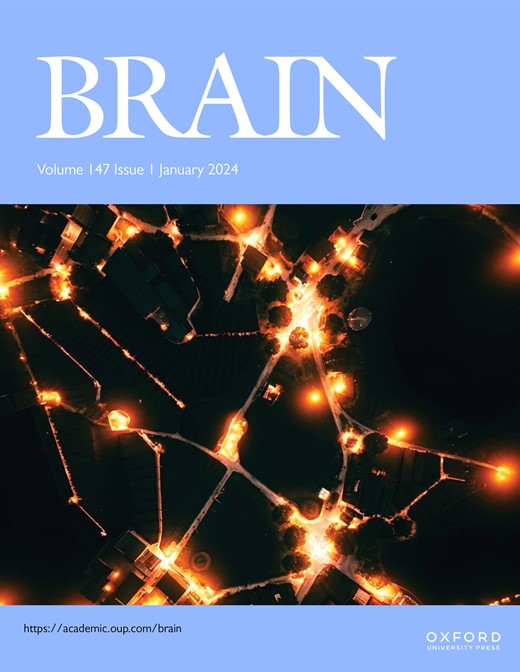At-home wearables and machine learning capture motor impairment and progression in adult ataxias
IF 10.6
1区 医学
Q1 CLINICAL NEUROLOGY
引用次数: 0
Abstract
A significant barrier to developing disease-modifying therapies for spinocerebellar ataxias (SCAs) and multiple system atrophy of the cerebellar type (MSA-C) is the scarcity of tools to sensitively measure disease progression in clinical trials. Wearable sensors worn continuously during natural behavior at home have the potential to produce ecologically valid and precise measures of motor function by leveraging frequent and numerous high-resolution samples of behavior. Here we test whether movement-building block characteristics (i.e., submovements), obtained from the wrist and ankle during natural behavior at home, can sensitively capture disease progression in SCAs and MSA-C, as recently shown in amyotrophic lateral sclerosis (ALS) and ataxia telangiectasia (A-T). Remotely collected cross-sectional (n = 76) and longitudinal data (n = 27) were analyzed from individuals with ataxia (SCAs 1, 2, 3, and 6, MSA-C) and controls. Machine learning models were trained to produce composite outcome measures based on submovement properties. Two models were trained on data from individuals with ataxia to estimate ataxia rating scale scores. Two additional models, previously trained entirely on longitudinal ALS data to optimize sensitivity to change, were also evaluated. All composite outcomes from both wrist and ankle sensor data had moderate to strong correlations with ataxia rating scales and self-reported function, showed differences between ataxia and control groups with high effect size, and had high within-week reliability. The composite outcomes trained on longitudinal ALS data most strongly captured disease progression over time. These data demonstrate that outcome measures based on accelerometers worn at home can accurately capture the ataxia phenotype and sensitively measure disease progression. This assessment approach is scalable and can be used in clinical or research settings with relatively low individual burden.家用可穿戴设备和机器学习捕捉成人共济失调的运动损伤和进展
开发脊髓小脑共济失调(SCAs)和小脑型多系统萎缩(MSA-C)的疾病修饰疗法的一个重要障碍是缺乏在临床试验中敏感测量疾病进展的工具。通过利用频繁和大量的高分辨率行为样本,在家中自然行为期间连续佩戴的可穿戴传感器有可能产生生态有效和精确的运动功能测量。在这里,我们测试了在家中自然行为中从手腕和脚踝获得的运动构建块特征(即亚运动)是否可以敏感地捕捉sca和MSA-C的疾病进展,正如最近在肌萎缩性侧索硬化症(ALS)和共济失调毛细血管扩张症(A-T)中所显示的那样。远程收集的横断面(n = 76)和纵向数据(n = 27)来自共济失调患者(SCAs 1、2、3和6,MSA-C)和对照组。机器学习模型被训练以产生基于子运动属性的复合结果度量。两个模型训练来自共济失调个体的数据,以估计共济失调评定量表得分。另外两个模型,以前完全训练纵向ALS数据,以优化灵敏度变化,也进行了评估。腕部和踝关节传感器数据的所有复合结果与共济失调评定量表和自我报告的功能有中等到强的相关性,在共济失调组和对照组之间显示出高效应量的差异,并且具有高周内信度。纵向ALS数据训练的综合结果最强烈地捕获了疾病随时间的进展。这些数据表明,基于家中佩戴的加速度计的结果测量可以准确地捕获共济失调表型并敏感地测量疾病进展。这种评估方法是可扩展的,可用于个人负担相对较低的临床或研究环境。
本文章由计算机程序翻译,如有差异,请以英文原文为准。
求助全文
约1分钟内获得全文
求助全文
来源期刊

Brain
医学-临床神经学
CiteScore
20.30
自引率
4.10%
发文量
458
审稿时长
3-6 weeks
期刊介绍:
Brain, a journal focused on clinical neurology and translational neuroscience, has been publishing landmark papers since 1878. The journal aims to expand its scope by including studies that shed light on disease mechanisms and conducting innovative clinical trials for brain disorders. With a wide range of topics covered, the Editorial Board represents the international readership and diverse coverage of the journal. Accepted articles are promptly posted online, typically within a few weeks of acceptance. As of 2022, Brain holds an impressive impact factor of 14.5, according to the Journal Citation Reports.
 求助内容:
求助内容: 应助结果提醒方式:
应助结果提醒方式:


